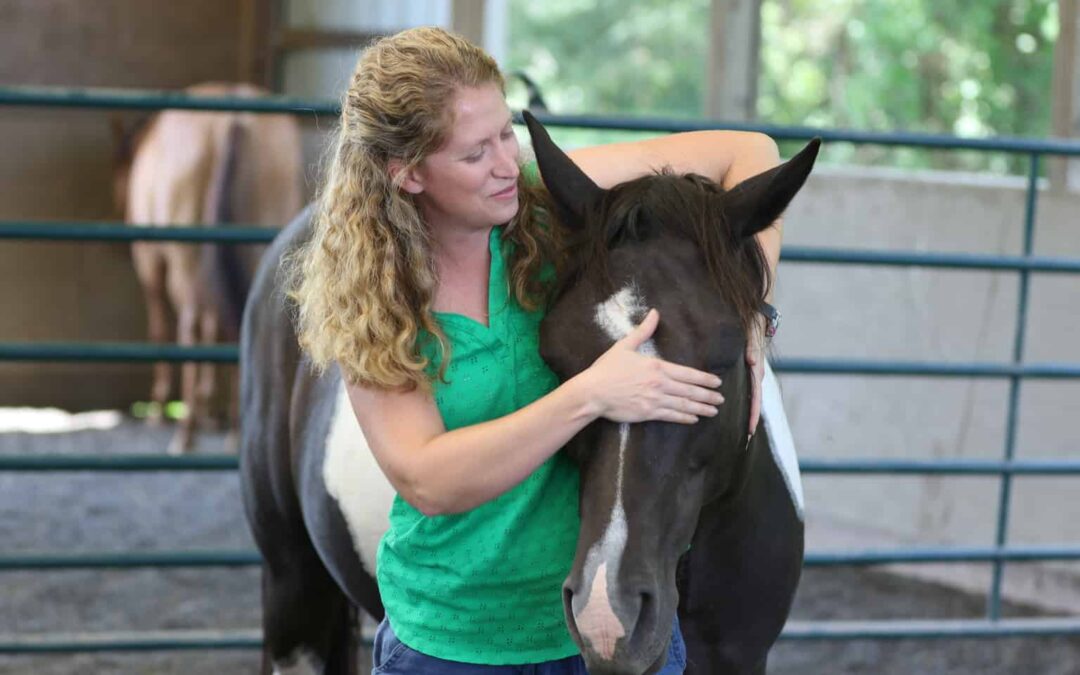
by Kathleen Choe | Nov 29, 2017 | Horsemanship, The Latest in Equine Assisted Therapy and Learning
A recent article published in the Journal of Equine Veterinary Science suggests that the concept of human leadership equating to the hierarchy in a horse herd, which has become foundational in many training approaches, is unreliable and largely irrelevant. Instead, the researchers found that consistent reinforcement of desired behaviors had a much greater effect on horses’ responses than the application of dominance or leadership types of interventions. Although the emerging language used in Natural Horsemanship training methods may sound kinder and gentler, the techniques employed still tend to be based on the use of power, domination and control, which ultimately removes the element of choice from the interaction and largely keeps a horse in his brainstem, where he is operating out of a survival, or fear response system.
The Natural Lifemanship approach to building relationships between horses and humans relies on the principles of pressure, or the raising and lowering of a calm, centered body energy, to invite connection as a choice coming from the horse’s neocortex. The horse always has the option to ignore, resist, or cooperate with the request. By creating a safe space for all of these responses, the horse learns to experience the positive benefits of being in a connected relationship with a human without fear or coercion. Releasing pressure when the horse makes the choice to cooperate uses negative reinforcement (the removal of a stimulus) to encourage positive behaviors. This lines up with what these researchers concluded after sifting through 100 scientific studies on horse behavior, where they found that “horses’ responses to training are more likely a result of reinforcement” rather than of humans taking a leadership role. The researchers ask, “could horses be assigned a more active role during training or are they merely followers with little autonomy if concepts such as leadership are applied in a training context?” Natural Lifemanship practitioners are all about giving horses an “active role” in developing healthy relationships!
To read the article, “Leaders among horses: Don’t count on humans being among them” go to https://www.horsetalk.co.nz/2017/02/09/leaders-horses-humans/
To learn more about Natural Lifemanship go to naturallifemanship.com
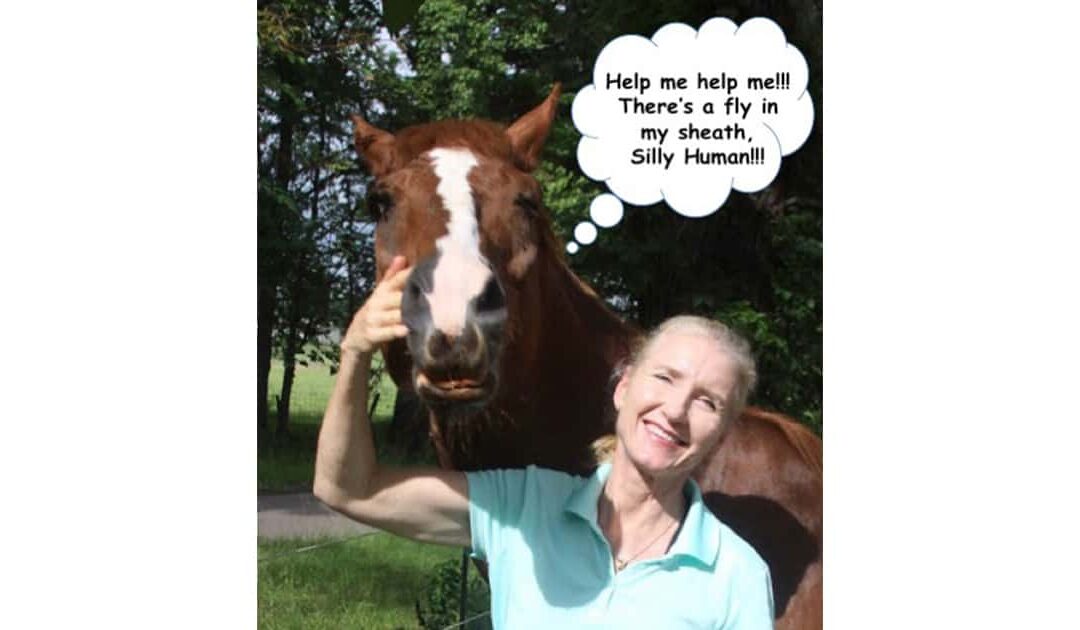
by Claire Hunter | Oct 2, 2017 | Horsemanship
Just yesterday while tacking up my horse, I was reminded how easy it is to mistake dissociation for cooperation. It is horse fly season around here, and we are currently inundated with a particularly vicious breed of huge, black, bloodsuckers. These savages pack a painful sting that I have experienced myself way too many times.
There I was, brushing down my horse Partner, when suddenly he was attacked by one of these nasty predators. I couldn’t see the fly, but Partner frantically whipped his tail around as he kicked and danced with his hind feet trying to get away from his tormentor. He was attached to a lead rope I was holding, and I went with his movement as I tried to locate and kill the offending vampire. He continued kicking at his sheath, so I finally reached up to make sure the fly had not landed inside, as they sometimes tend to do. Discovering an unpleasant “goo” that had accumulated on an extra hot and humid day, I only did a brief check before withdrawing my hand.
As I cleaned off my hand with a wipe, Partner became very still, so I hoped that the fly had gone away. I put on his saddle pad and saddle, and when I attached the girth, I noticed how very still he remained. We have been working on comfortable acceptance of the girth, so as I progressively tightened it, I thought, “Wow, maybe he’s finally getting it! Maybe he realizes this is just no big deal! Maybe his ulcer medication helped! Maybe he appreciated my efforts to help him remove that fly!” I was feeling optimistic that we had crossed a training milestone, but what I did not realize was that he was not cooperating…he was simply not there. He was, in fact, frozen.
This became obvious when, once he was bridled and ready to ride, he swatted his tail at his sheath again. I decided I really needed to check that out one last time just in case there was a fly in there, but this time I grabbed a rag and covered my hand before going in. Sure enough, with more extensive exploration, I located one of those gigantic critters inside. I pinched the fly hard and yanked him out. The rag had a big blood spot around the now squashed fly, and I felt awful that Partner had just been standing there suffering for so long while that evil bug feasted on my sweet friend’s tender flesh.
Luckily he was not seriously impaired by his small but painful injury, and we went on to have a pleasant ride. But the experience did influence the ride, because I continued contemplating how often this horse may have appeared to be cooperative when really he was just offering the sort of compliance that comes with dissociation. As a rider, it is so easy to respond in ways that shut down expression rather than looking deeper for what is really happening with the horse. Partner had just shown me how much immediate pain he is able to ignore, and I feel as if I have been put on notice that I must always encourage him to express himself so that I respond as a good partner should. I also had to acknowledge that I have not established the sort of relationship with him where he would continue asking for help rather shutting down when he decided I couldn’t or wouldn’t help.
As a therapist, I was reminded of how often in relationships, especially between parents and children, we mistake submission for cooperation. When we assume that everything is good just because the child is compliant, we often miss important information and fail to notice subtle messages that would reveal the root of problems the child may be experiencing. Becoming attuned to the difference between compliance, which comes from the survival part of the brain, and cooperation, which comes from the “thinking” part of the brain, begins with noticing the contrast between an individual who is frozen vs. one who is consciously choosing to cooperate with a request.
Rather than being attuned when Partner got very still, I became task-oriented thinking it was great that things were going so smoothly. And yet he was hurting inside the entire time…if I had just noticed that his eyes were a bit vacant, or his breathing a bit shallow, I might have continued exploring whether that fly had really gone away. Sometimes we have to stop and consider whether we are really attuned to the other and accurately interpreting their signals in order to build and deepen our relationship.
For more information about how to tell when your horse is dissociating check out this blog by Reccia Jobe.
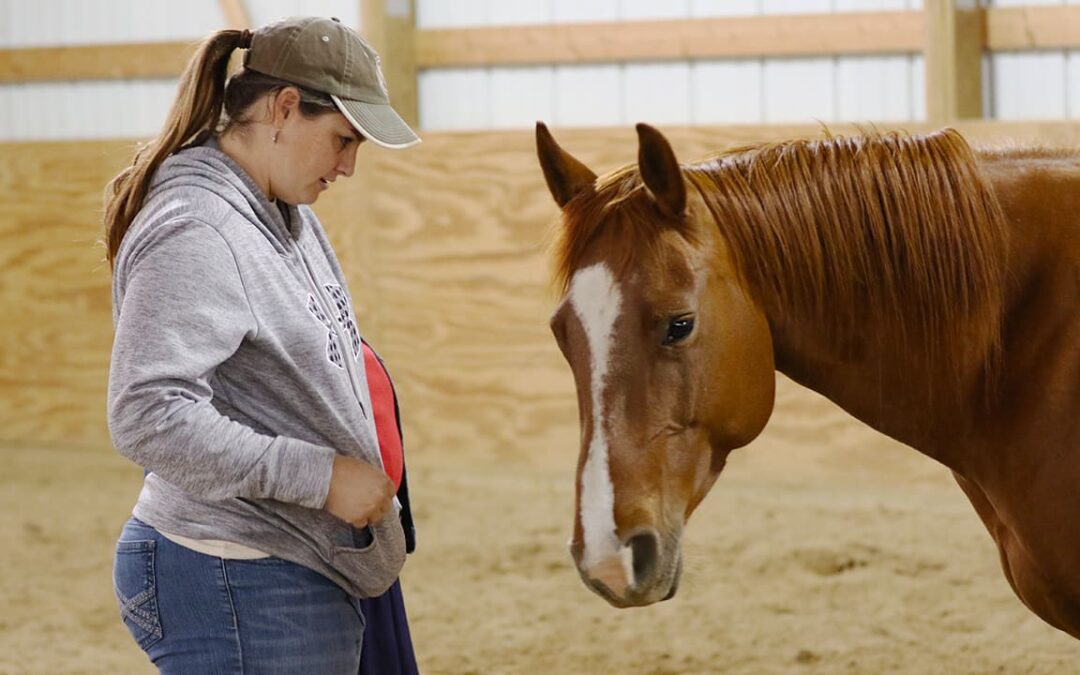
by Reccia Jobe | Aug 2, 2017 | Horsemanship
Many equine professionals have a difficult time identifying the difference between compliance/ submission and cooperation in a horse.
This is an important skill to develop for your work in the Natural Lifemanship model, whether you are practicing TF-EAP, teaching riding lessons, training your horses, or coaching a client in professional or personal growth and development. If you’ve been to a Fundamentals of Natural Lifemanship training, you may recall your trainers talking about the difference between compliance and cooperation. You may have experienced the difference in your round-pen work with the horses at your training.
Neurobiologically, in both humans and horses, the difference between compliance and cooperation is dependent on which part of the brain the behavior or action is coming from. If the action is done out of alarm, fear, or terror, it is originating in the lower regions of the brain, and is, therefore, compliance (I can’t escape this pressure or fight it and remain safe, so I must submit to it in order to survive).
Remember that compliance is an adaptive survival response. Cooperation is a whole-brain resilient response. Cooperation happens when the lower regions of the brain are regulated and the higher regions of the brain are able to communicate and respond appropriately. The horse makes a choice to cooperate, rather than doing what you’ve requested because he feels he must to survive.
In order to help you identify when dissociation or compliance is happening with your horse in your TF-EAP sessions or with your work with him, I have compiled a list of 6 outward signs you can observe that may indicate your horse is complying, submitting, and dissociating. This is not an exhaustive list, and is not meant to stand alone.
Please don’t walk away from this list believing that any time a horse shows any of these signs, it means he’s dissociative. Use your, your mental health professional’s, and your client’s discernment in understanding what is happening in the horse within the context of the relationships at play. This list assumes observation of a horse in good physical condition with no known health problems (horses with chronic pain or health problems are likely to be dissociating from this pain on a regular basis).
1. Your horse’s body looks relaxed, eyes may even be softened and closed, but the jaw is tense and tight. He may show excessive licking and chewing, sometimes exaggerating these movements.
2. Right before the horse did what was requested, the horse was resisting (running or fighting) and began licking and chewing during the resistance right before he did what was requested. Imagine a horse running around a round pen when you are asking for attachment. He runs and runs, begins licking and chewing while running, then suddenly turns towards you and starts walking toward you. That’s compliance, not cooperation.
3. Your horse is complying with your request but is showing other signs of discomfort or tension such as: rapid breathing, wide eyes, whites of eyes showing, tightness in jaw, tightness around pole and ears, stiff and/or jerky movements, or head held very high with a tight neck.
4. Your horse does what you have asked, then as soon as the request or pressure is released, he moves away from you as quickly as he can.
5. Your horse does what you have asked, but when you change the request or change the pressure (increase or decrease) he doesn’t seem to notice. He may even appear to be falling asleep at this time.
6. Your horse quickly starts falling asleep while standing up to the point that he is losing balance, his knees are buckling, and he is falling to the ground, sometimes hitting his nose on the ground before he appears to notice what is happening. His knees buckle and he may even rest on his knees with his rear still up and eyes still closed for a few seconds before either falling all the way down or jerking his eyes open and head up before standing back up. This can look and feel like your horse has fainted or passed out.
This one is seen less often because it is a more extreme form of dissociation for a horse. In my experience, this can be a good indication that this horse has a very strong pattern of dissociation and had likely been acting in a state of compliance and submission long before you observed this behavior.
Reccia Jobe partners with therapists to offer TF-EAP. She also does equine assisted personal development and life coaching. For more information visit www.pecancreekeap.com
To learn more on this subject join us at Interconnected 2020 October 21st – 25th – a virtual conference hosted by Natural Lifemanship – and participate in the following workshops:
Hidden in Plain Sight: The Signs and Symptoms of Dissociation Parts 1-3
Consent and THIS Horse Parts 1-2
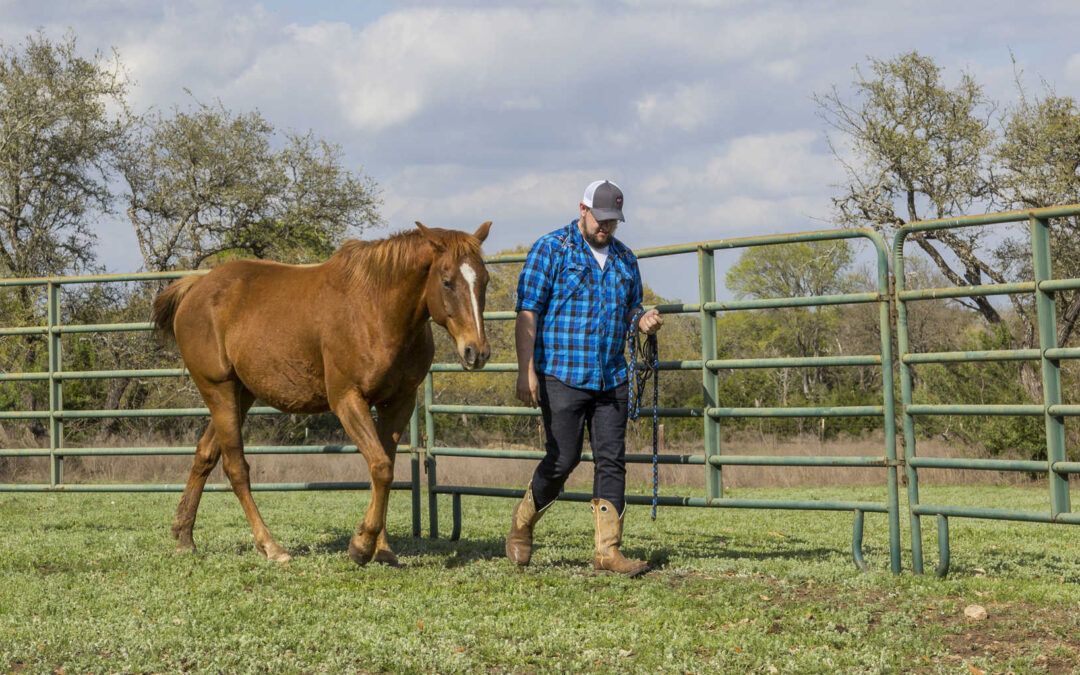
by Rebecca Hubbard | May 23, 2017 | Basics of Natural Lifemanship, Horsemanship
“Isn’t Natural Lifemanship (NL) just joining up?” I hear this question frequently from family, friends and students who are learning Natural Lifemanship. If they know anything about Natural Horsemanship, horse training methods with the intent of developing rapport with a horse based on herd dynamics, they assume that attachment in NL is “joining up.” Since joining up is getting the horse to see you as his leader and to follow you, observers often confuse this with attachment and connection in NL. Attachment can involve having the horse follow you but can also be achieved in many different ways. Further exploration of the process of attachment in NL reveals not only different expectations and beliefs about the process but a different process altogether. The beliefs and intentions of Natural Horsemanship and NL are not the same but both have important places in the world of horses.
In this blog I break down the components of joining up and attachment and compare and contrast them to help students of NL better understand the differences. Joining up and attachment have different purposes. Joining up is an intervention used by men and women (who we will call “trainers”) to train horses using principles from herd dynamics and attachment is part of NL, a psychotherapy model that strives to help humans obtain healthier relationships with themselves and others.
Joining Up is a term that is frequently used in Natural Horsemanship to communicate the process of a horse respecting the trainer as his/her leader. How this is done varies slightly from person to person. Monty Roberts explains it this way:
Working in a round pen, one begins Join-Up® by making large movements and noise as a predator would and begins driving the horse to run away. She then gives the horse the option to flee or Join-Up®. Through body language, the trainer will ask, “Will you pay me the respect due to a herd leader and join and follow me?” The horse will respond with predictable herd behavior: by locking an ear on her, then by licking and chewing and dropping his head in a display of trust. The exchange concludes with the trainer adopting passive body language, turning her back on the horse and without eye contact, invites him to come close. Join-Up occurs when the animal willingly chooses to be with the human and walks toward her accepting her leadership and protection.
From an NL perspective what is involved in this type of joining up? The horse trainer uses the horse’s natural fear of predators and approaches the horse with predator type behavior which frightens the horse and drives the horse into the survival part of his brain causing him to run away from the threat. From the survival part of his brain the horse responds instinctually. When the horse cannot escape the threat, he submits. The change in the trainer’s behavior to less threatening and more passive body language offers possible safety. The horse seeking safety, looks to the trainer for this and begins to ask for permission to approach. When the horseman allows the approach, the horse submits to the trainer as the leader.
Horses are accustomed to being dominated or being the dominant one, so in Join-Up® the interactions reinforce the hierarchy of the herd dynamics. From a horse training perspective this is a much kinder way to get a horse to comply with your requests than to “break” him. From a psychotherapy or NL perspective this interaction is about dominance and control. The horse is not given an option to cooperate because cooperation only occurs when the neocortex (the thinking part of the brain) is engaged and not only the lower regions of the brain. The trainer has all the power in this interaction and though Mr. Roberts uses the word “choice” the horse is not given a choice since he is operating out of the survival parts of his brain. True choices are made from the neocortex.
Let’s look at the above interactions through the lens of human relationships because NL is a psychotherapy model designed to help humans with relationships. A very important principle in NL is “a sound principle is a sound principle no matter where it is applied.” So, in NL we believe that if a principle is sound it will work across different types of relationships. The transfer of these principles is imperative in a therapy model.
When applying the principles from the Natural Horsemanship Join-Up® process to human relationships we see the following: One person has all the control, the relationship is based on a strong, benevolent leader that must be obeyed in order for there to be safety and order. The other person is not allowed to have any control because they may make poor decisions and submission is desired because it is good for the relationship. When viewed within this lens very few people would say that is the type of relationship they want and many would say that it is abusive. Since NL is a psychotherapy model, if we used the Natural Horsemanship principles of Join-Up® we would be teaching people unhealthy ways of relating.
Another very respected natural horseman is Pat Parelli. Like Mr. Roberts he is a well-known and a highly respected horse trainer. In his trainings Mr. Parelli explains how important it is to control a horse’s movement because it raises the trainer’s status to one of leader in the horse’s eyes. In this interaction the trainer is using the herd principle of whoever moves the other’s feet has the status. In this way the person controls the horse by influencing the horse’s feet. Sometimes this involves blocking choices that the horse can make. Sometimes the trainer decides which direction and how fast the horse will go. Leadership is seen as an essential component of the horse and horsemanship relationship. Mr. Parelli notes that if the trainer does not make the decisions then the horse will. Unlike Mr. Roberts, Mr. Parelli does not take the stance of a predator in order to drive the horse away. He uses only the amount of pressure necessary to control the horse’s feet.
When examining these beliefs, we see the following: The trainer controls the horse’s movements and takes away choices as necessary to obtain the horse’s compliance, and the horse cannot appropriately control himself without leadership.
From a human relationship perspective once again one person has all the control and decision making ability as the benevolent leader. The leader controls the other person and limits the choices available to insure appropriate decision making. Like the outcome of Join-Up® these dynamics do not reflect a healthy human relationship pattern.
All of these Natural Horsemanship interactions use operant conditioning, pressure and release, to teach the horse the desired behaviors. NL also uses pressure and release but in a different fashion.
One small part of NL is requesting attachment by applying pressure to the hip of the horse. From the untrained eye this appears similar to Join-Up® or other joining up interactions. There are many significant differences, however.
In NL the intention of every interaction with a horse or human is connection. Submission is seen as an instinctual behavior that the horse or human makes from the survival part of his brain and is undesirable. In order to avoid submission, the trainer/client uses the smallest amount of pressure necessary and abides by the three principles of pressure which are: Ignore- increase, Resist- remain and Cooperate- release and/or decrease.
The process of attachment in NL looks like this. The trainer/client makes a request of the horse in order to begin their relationship. The trainer/client applies pressure to the hip of the horse in order to give the horse the most choice about how to respond (the intent is not to drive the horse). The horse can choose to ignore the request (seem to not notice the request, do nothing in response to the request), resist the request (seek a different answer than the one that is being requested) or cooperate with the request.
Before a request is made the trainer/client must first decide if the request is appropriate, fair, and good for both the trainer/client and the horse. If the request is not good for one of them then it ultimately is not going to be good for the relationship. Each request is made with the smallest amount of pressure possible, usually beginning with just a thought. For example, the thought could be, please look at me. In order to use the smallest amount of pressure the trainer/client must be emotionally regulated and be in control of herself. The trainer/client holds a belief that he/she can only appropriately control himself/herself and the horse can appropriately control himself. If the horse responds to the smallest amount of pressure, then the pressure is released to communicate to the horse, yes that was what I asked for.
However, if the horse ignores the request, that is the trainer/client did not apply enough pressure to convey the request, then the pressure is increased incrementally with warmth and compassion. The decision to increase the pressure incrementally is done so as not to drive the horse into the survival part of his brain and to give the horse the choice to respond with the least amount of pressure possible.
In order to increase the pressure a little the trainer/client may take a deep, long breath to bring up the energy in his/her body while seeing in his/her mind the horse looking at him/her. If the horse responds by looking, the pressure is immediately released. But if the horse responds with a different answer, the trainer/client keeps the pressure the same in order to convey to the horse, that is a nice try but not what I requested.
By keeping the pressure the same the trainer/client does not drive the horse deeper into the survival part of his brain. As the pressure remains the same the horse can come out of the initial survival mode and begin to use his neocortex in attempting to find the answer that the trainer/client requested. The trainer/client keeps the pressure the same as the horse explores what the answer to the request is.
This dance continues until the horse chooses on his own to cooperate with the request. The desire is for the horse to engage his neocortex and to think and to choose connection with the trainer/client. If the horse submits instead of cooperating, then the trainer/client knows that he/she increased the pressure during resistance (hunting an answer). This is an undesirable outcome and the dance begins again with the smallest amount of pressure until cooperation is achieved from the horse’s neocortex.
The dance of asking the horse to follow is built on scaffolding of the requests. It may start out with the request for an ear, or an eye then move to a whole head turn, then the horse’s body turning to face the trainer/client, then the horse making a step toward the trainer/client and lastly them taking a walk together. The request to walk together is made out of a desire for connection and not to be the leader of the horse.
If we examine attachment and these steps of getting a horse to follow through the lens of a human relationship, we find respectful requests made with warmth and compassion, allowance and respect for another’s choice, a genuine desire to connect, acceptance of the other’s response, compassion and warmth in helping them find the right answer to the request, and a respect for and allowance of the thinking process and autonomy of another. In this process the trainer/client and horse are equal partners, each brings strengths and weakness to the partnership. This would be the same for all relationships, such as couples and friendships.
When the intention and principles behind the processes of attachment in NL and joining up in Natural Horsemanship are fully examined, attachment in NL is very different from Join-Up® or joining up in Natural Horsemanship. Remember, in NL there are infinite ways to ask for attachment, putting pressure on the hip is just one of them. Attachment can be requested any number of ways, and how it is asked depends on creativity and attunement in the relationship.
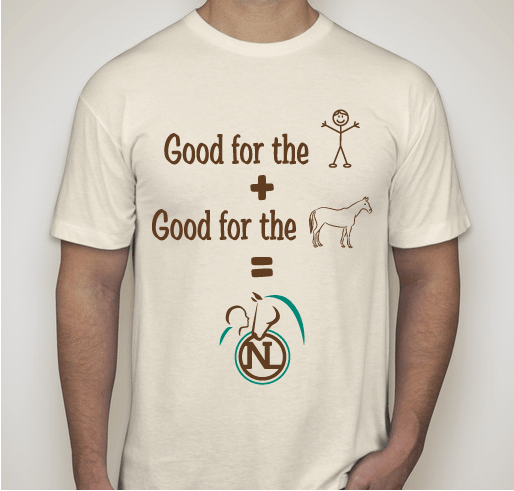
by Tim Jobe | Jan 27, 2016 | Basics of Natural Lifemanship, Horsemanship
I think quite a few of life’s problems are the result of one sided relationships. As we travel the country working with people and horses, the one sided relationship seems all too prevalent. We see people who do everything they can to meet the needs of their horse but never ask the horse to meet any of their needs. I guess the people are getting some need met at some level but the horse is not having to do anything except be present. They feed it, they groom it, and they worm it, provide it with fresh water, and trim its feet all the while asking it to contribute very little to the relationship. When they do actually ask the horse to do something they are met with resistance or the request is ignored. They then seem disappointed that their loving horse is treating them so rudely. They shouldn’t be surprised because that is the way they set up the relationship to begin with. They are often afraid to ask anything of the horse because they are afraid the horse might blow up. So they go about their relationship not asking for anything that might cause a blow up. They somehow justify it by saying things like “It is my responsibility to provide for this horse’s needs because it can’t do these things for itself.” That may be true but it is capable of meeting some of the humans needs also. We believe that a relationship that is not good for one is eventually not good for either. Any time a relationship is one sided it is eventually going to cause some problems.
(more…)

by Tim Jobe | May 7, 2012 | Basics of Natural Lifemanship, Horsemanship
Before you start shooting, give me a chance to explain. Would you say that in your marriage your spouse is a mirror? I don’t think I could get away with that. My spouse will react or respond to my emotions, thoughts or feelings, but definitely doesn’t mirror them back to me. I think this also happens in a relationship with a horse. The horse responds or reacts to whatever is going on with me and hopefully I do the same thing for the horse. The horse doesn’t mirror my actions. In fact, horse training would be much easier if only this was the case.
(more…)







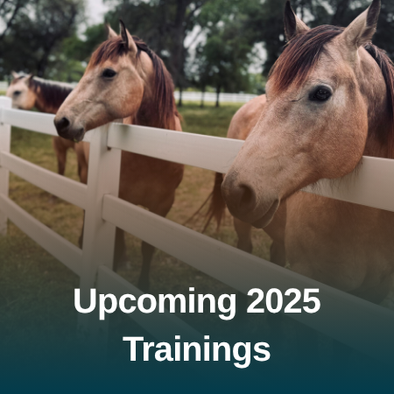
Recent Comments